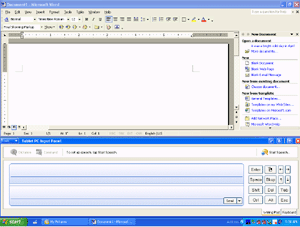The Tablet PC: An in depth look with the FIC SlateVision
by Matthew Witheiler on December 12, 2002 7:43 AM EST- Posted in
- Laptops
Software: Input Panel
Sure, handwriting recognition works wonderfully in applications designed for it, such as Windows Journal, but what about applications that do not have built in handwriting support like Internet Explorer and Word? How does one insert typed text into these applications? Using the Input Panel, of course. The other piece of software driving Windows XP Tablet PC Edition is the Tablet PC Input Panel, a bar that docks on the bottom of the screen and allows for input via the tablet's pen (it can also be set to float for those who do not like losing the desktop space taken by docking the bar).
The Input Panel provides the user with a number of input methods to chose from. Perhaps the most useful is the writing pad feature of the Panel. In this mode, the Input Panel displays one or two blank lines on which text can be written and translated into text. The text is written using the pen on the Input Panel lines and then sent into the active application after a user defined delay period. We found ourselves using this method of input the majority of the time, using it to type in web addresses, share locations, and quick Word notes. To the right of the writing pad lies a set of quick buttons that give access to commonly used functions such as shift, control, and backspace. Speaking of backspace, if you make a mistake or decide not to insert the text you were writing, words written in Input Panel can be scratched out to be flagged to not be translated. Again, Microsoft implemented this feature in an attempt to make the Tablet PC feel as much like pen and paper as possible.
The text recognition engine used in Input Panel is the same as that used in Windows Journal, so the recognition accuracy turned out to be very good. We had very few problems using the panel to input text into applications that do not natively support handwriting.
If handwriting is not for you or if you need to perform a unique combinations of key strokes, the Input Panel software also offers an onscreen keyboard. The keyboard lies in the area reserved for the Input Panel and includes fairly large and easily accessible buttons that can be tapped using the pen. Through testing we actually found the handwriting method of input to be faster and fairly error free. In fact, we only really ended up using the keyboard when entering passwords, as the handwriting recognition tends to have problems converting a random string of letters and numbers into correct text (since it tries to pick a known word out of its dictionary first).
The final input method offered by the Tablet PC Input Panel is the voice recognition method. Previously only available to Office XP users, the speech function of Input Panel allows users to perform basic functions and input text using their voice. Like other speech engines, you have to train the speech feature of Input Panel to recognize your voice via a 5 to 10 minute reading session. After that, speech can be used to enter text in any application. The speech engine appears to be the same one used by Office XP, so if you have experience using that program you should find the results provided by the speech feature of Input Panel familiar.












2 Comments
View All Comments
hemadoi - Thursday, November 15, 2018 - link
Hey! Great post on the topic, I really enjoyed with this article. I have just know about that Windows XP Tablet PC Edition maintains the full functionality of Windows XP Professional, including the advanced networking functions of the operating system.I also try to knows about MS Office and other Microsoft products at:
Thanks for sharing a valuable post!!!
samsun8521 - Wednesday, January 23, 2019 - link
That's a great web portal for me.